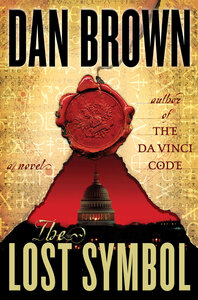Dan Brown proves he’s a Symbol of popular fiction
Life is unfulfilling. You go to class or work and try to get something done. You grout the spaces between your chunks of obligation with lesser obligations: errands, research, meetings, chores. Any excess room in your schedule is cluttered with attempts at relaxation: socializing, grooming, YouTube-ing, book reading or just zoning out.
But in spite of your packed agenda, it often feels like something is missing. And then, in a flash of blinding recognition, you realize that Dan Brown held the last piece to your satisfaction all along.

Best seller · The Lost Symbol is the third Dan Brown novel centered around fictional symbologist Robert Langdon. The thriller, which takes place in Washington, DC, is already the fastest selling adult novel in history. - Photo courtesy of Randomhouse
The third installment in the life of protagonist Robert Langdon, The Lost Symbol catapults audiences into a world where Washington, DC is a Masonic mecca and one middle-aged Harvard symbology professor trumps even the CIA in his ability to save our nation from peril.
Lured on false pretenses to the capital by security threat Mal’akh, iconographer Langdon watches helplessly as his keynote-speech evening is warped into a quest to appease a terrorist by the unwelcome appearance of human sacrifice in the Capitol rotunda. The CIA, the Freemasons, Mal’akh, and old acquaintance and noetic scientist Katherine Solomon all vie for the symbologist’s attention in decoding the legendary Freemason pyramid. Meanwhile, the clock ticks down for Peter Solomon, Katherine’s brother and father-like mentor to Langdon.
As the swatch of text heading his novel labeled “FACT” reveals, the Masonic underpinnings of DC, the field of noetic science and the Smithsonian Museum Support Center all exist. The Smithsonian safeguards more than 30 million historical artifacts — and fictional Katherine’s research. Much like in his two prior New York Times’ best sellers, Angels and Demons and The DaVinci Code, Brown aggregates thorough background research with his literary parallel universe.
This habit provoked some defensive talk from the author in his Sept. 15 interview with Matt Lauer on the Today Show.
“I do something very intentional and specific in these books,” Brown stressed. “And that is to blend fact and fiction in a very modern and efficient style — to tell a story. There are some people who understand what I do, and they sort of get on the train and go for a ride and have a great time, and there are other people who should probably just read somebody else.”
For those who can tolerate his liberal play on history, Brown’s intellectual triumph in The Lost Symbol mirrors his writing style; the uncertainty of what is real and what is Brown’s brainchild taunts readers, inspiring them to hurtle on and discover the truth for themselves.
This mechanism of teasing, delaying revelation and dropping just enough clues to keep audiences hastily flipping through his pages is central to all Brown’s novels, and makes for addictive tomes that easily absorb 10 hours of your life in one sitting.
Brown knows how to write popular literature, and for someone who originally moved to Hollywood to become a pop musician, it’s not all that surprising that he packages a lucrative product. (Doubleday printed 5 million copies of The Lost Symbol banking on this very skill.)
But Brown clearly wants his book to be more than a page-turner.
“I’ve thought a lot about life,” he told Lauer. “And I’ve spent a lot of time studying history and science. The theme of this book has a lot to do with the power of our thoughts. And I have great hope for the future and try to nudge the future with this book in certain directions.”
While evidence that the novelist TIME magazine placed in its 2005 list of the 100 most influential people worldwide has a conscience is reassuring, Brown’s big epiphany in The Lost Symbol falls short of expectations, given the climactic climb preceding it. With the loftiness of religious doctrine, Brown invokes his personal realizations in print, attempting to quell years of religious dissent with some conventional logic.
Brown’s novel, however, does unwittingly tap into something bigger than himself. His nuanced understanding of human curiosity might ensure that his books fly off vendor shelves, but it also is a testament to something that does unite us all: the need for something more entertaining than our daily lives.
